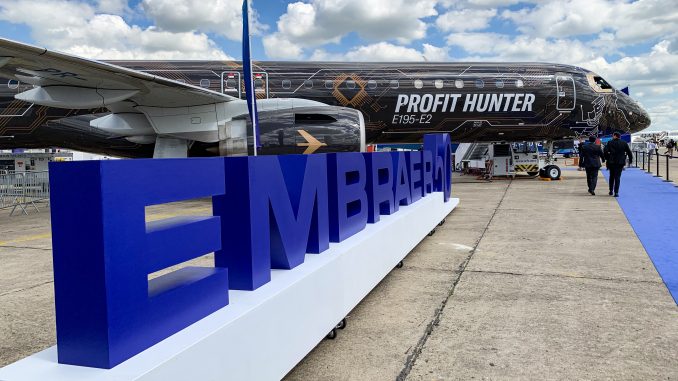
50 years ago today, on 19th August 1969, the Brazilian government formed a new aviation company called Empresa Brasileira de Aeronáutica, better known as Embraer. Today, the company produces a range of commercial, military and business aircraft, and is one of the largest aircraft manufacturers in the world. Let’s take a look at the company’s history in the commercial market.
Early days
The company’s first aircraft was introduced in 1973. Called the Embraer EMB 110 Bandeirante, it was a light twin-turboprop aircraft capable of carrying 15 to 20 passengers in a three-abreast configuration over a range of approximately 1200 nautical miles (1960km). This was followed in 1985 with the introduction of the Embraer EMB 120 Brasilia.
The Brasilia is another small twin-turboprop airliner, but features many technological advances over the Bandeirante. It offered a larger capacity of 30 passengers, with a range of up to 945nm, or 1750km. Quickly becoming popular amongst the slow growing regional airlines, the Brasilia started to earn Embraer a reputation for building high quality small aircraft. A total of 354 EMB 120s were built between 1983 and 2001, when production ceased.
Building momentum
Off the back of the EMB 120, Embraer looked into developing a new regional jetliner. The manufacturer launched the ERJ145 (ERJ standing for Embraer Regional Jet) program at the 1989 Paris Air Show (called the EMB145 at that time), and it would be based heavily on the Brasilia. Featuring wing mounted jet engines on a new wing, it would extend the capability of the EMB 120. Ultimately, this design wasn’t pursued due to the ground clearance required for the engines, and so the engines were moved to the tail, in a standard T-tail configuration, a design formula that became incredibly popular with the Douglas DC-9, and most importantly, its main rival, the Canadair (later Bombardier) CRJ family.
Maintaining the fuselage of the EMB 120 (albeit stretched to accommodate 50 passengers), the ERJ145 first flew in 1995, with two shortened variants following shortly afterwards: the 44 seat ERJ140, and 37 seat ERJ135. The ERJ135 would go on to be also sold as a private jet, under the name ‘Embraer Legacy 600’. After a slow start, soaring fuel prices and reduced demand following 9/11 meant an increase in popularity of small regional jets. As a result, a total of 1,213 ERJ family aircraft were built until the end of production in 2016.
A main player
In 1999, after the roaring success of the ERJ family, Embraer was looking to expand its position as a regional aircraft manufacturer, and establish itself as the market leader. To do so, it introduced the E-Jet family. Comprising of four all-new models, from the 72-seat E170 to the 116-seat E195, Embraer could finally adopt the traditional wing mounted jet design that it had originally planned for the ERJ. The first E170 flew in 2002, and the family range has achieved exactly what it set out to do, in becoming a go-to regional jet for airlines over the world.
With a range of 2,150nm (3,982km) for the E170 through to the E195 with a range of 2,300nm (4,260km), the E-Jet family provides a four abreast layout on segments that would previously require more expensive larger aircraft such as the Airbus A318/19 or Boeing 737-600/700, with many financial advantages to boot.
Also of note is the aircraft family’s relatively short field performance and steep approach certification, meaning it can access smaller, hard to reach airports that larger aircraft aren’t suitable for (for example London City Airport). The only comparable larger aircraft with such capabilities is the Airbus A318, of which only 80 were ever built. In comparison, Embraer has built over 1,500 E-Jets to date, including the next-generation E2 family. The Embraer E190 is also offered in a business variant, called the Embraer Lineage 1000.
To the future
At the 2013 Paris Air Show, Embraer announced the E2 program, to further enhance the E-Jet family to better compete with the Airbus A220 (then Bombardier CSeries) and keep its high market share. Featuring improvements to the cabin, aerodynamics, avionics, new wings and geared turbofan engines, the E-Jet E2 family is made up of three members. The smallest is the E175-E2 with a capacity of 80 passengers (the E170 size was dropped), the 96 seat E190-E2 and the 120 seat E195-E2; the latter being the largest aircraft Embraer has ever built. With a wingspan of 35.124m, it eclipses the 33.9m wingspan of Embraer’s former largest aircraft, the military KC-390 transport/tanker.
The E190-E2 entered airline service in 2018 with Widerøe, the E195-E2 received certification earlier this year and is due for its first delivery in late 2019/early 2020, and the E175 is scheduled for its first flight before the end of 2019, with deliveries to start in late 2020/early 2021.
At the Farnborough Airshow 2018, after months of speculation, Boeing and Embraer announced that Boeing would be purchasing an 80% stake in Embraer’s commercial aviation section. The companies later stated, after the deal received approval from the Brazilian government, Embraer would be renamed to “Boeing Brasil-Commercial”. The details of the deal are still unclear and are expected to conclude in late 2019.
Matt is a Berlin-based writer and reporter for International Flight Network. Originally from London, he has been involved in aviation from a very young age and has a particular focus on aircraft safety, accidents and technical details.



